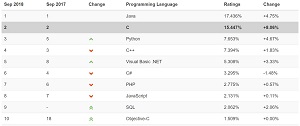News
Open Source Python Reaches New Heights in Popularity Ranking
- By David Ramel
- September 5, 2018
The new report from the TIOBE index of programming language popularity notes that for the first time, the open source Python has cracked the top three, displacing 33-year-old workhorse C++.
Released in 1991, Python covers many bases, being known for its simple onramp and ease of use even though it's a favorite among many demanding data scientists for cutting-edge analytics and artificial intelligence projects.
Perhaps capitalizing on the growth of such projects, Python has climbed steadily in language popularity rankings:
- Earlier this year, the PYPL PopularitY of Programming Language chart reported Python was on the verge of overtaking perennial No. 1 Java.
- Just last month, IEEE Spectrum published its fifth annual interactive ranking of the top programming languages, which saw 2017 champ Python again in first place.
- Also last month, we reported that the RedMonk report (for June) listed Python at No. 3, the same position it held the year before, behind only JavaScript and Java.
- Earlier this year, a developer skills report from recruiting company HackerRank said: "JavaScript may be the most in-demand language by employers, but Python wins the heart of developers across all ages, according to our Love-Hate index. Python is also the most popular language that developers want to learn overall, and a significant share already knows it." The Love-Hate index measures the percentage of developers who love a language while subtracting the percentage of developers who dislike the language.
- In June, we reported that the Hacker News' April 2018 Hiring Trends analysis indicated Python was the No. 2 most-in-demand skill, behind only React.
Previously, the TIOBE Programming Community index foreshadowed Python joining its top three, saying in the August report: "This time Python was a clear winner with more than 70 percent 'market share.' This Python boost is also visible in the TIOBE index. But industry is adopting Python as well. The Python programming language started as a successor of Perl to write build scripts and all kind of glue software. But gradually it entered also other domains. Nowadays it is quite common to have Python running in large embedded systems. So it is very likely that Python will enter the top 3 and even might become the new number 1 in the long run."
 [Click on image for larger view.]
TIOBE Index Top 10 for September 2018 (source: TIOBE index)
[Click on image for larger view.]
TIOBE Index Top 10 for September 2018 (source: TIOBE index)
And, indeed, it did enter the top three in the new September report on the strength of 4.67 percent growth from September 2017 (though Java and C retained their top two slots on even higher percentage growth rates). C++, with 1.83 percent growth, relinquished its top-three position, falling to No. 4.
"Python has entered the TIOBE index top 3 for the first time in its history. This really took a long time," the report said. "At the beginning of the 1990s it entered the chart. Then it took another 10 years before it reached the TIOBE index top 10 for the first time. After that it slowly but surely approached the top 5 and eventually the top 3. Python is becoming increasingly ubiquitous. It is already the first choice at universities (for all kinds of subjects for which programming is demanded) and is now also conquering the industrial world. Python's selling points are easy to learn, easy to install and easy to deploy."
The new report also saw Objective-C make a big jump from No. 18 to No. 10, while big moves downward in the top 20 were shown by Perl (falling from No. 9 to No. 17), R (from No. 11 to No. 18) and Visual Basic (down to No. 20 from No. 14, though the more modern variant, Visual Basic .NET, rose from No. 8 to No. 5).
"Other interesting moves this month are: Rust jumps from No. 36 to No. 31, Groovy from No. 44 to No. 34 and Julia from No. 50 to No. 39," the TIOBE report said.
About the Author
David Ramel is an editor and writer at Converge 360.